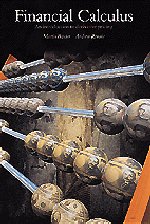Chapter 3 - Continuous processes
Published online by Cambridge University Press: 05 February 2014
Summary
Stock prices are not trees. The discrete trees of the previous chapter are only an approximation to the way that prices actually move. In practice, a price can change at any instant, rather than just at some fixed tick-times when a portfolio can be calmly rebalanced. The binary choice of a single jump ‘up’ or ‘down’ only becomes subtle as the ticks get closer and closer, giving the tree more and ever-shorter branches. But such trees grow too complex and we stop being able to see the wood.
We shall have to start from scratch in the continuous world. The discrete models will guide us — the intuitions gained there will be more than useful — but limiting arguments based on letting δt tend to zero are too dangerous to be used rigorously. We will encounter a representation theorem which establishes the basis of risk-free construction and again it will be martingale measures that prime the expectation operator correctly. But processes and measures will be harder to separate intuitively — we will need a calculus to help us. And changes in measure will affect processes in surprising ways. We will no longer be able to proceed in full generality — we will concentrate on Brownian motion and its relatives. If there is one overarching principle to this chapter it is that Brownian motion is sophisticated enough to produce interesting models and simple enough to be tractable.
- Type
- Chapter
- Information
- Financial CalculusAn Introduction to Derivative Pricing, pp. 44 - 98Publisher: Cambridge University PressPrint publication year: 1996



